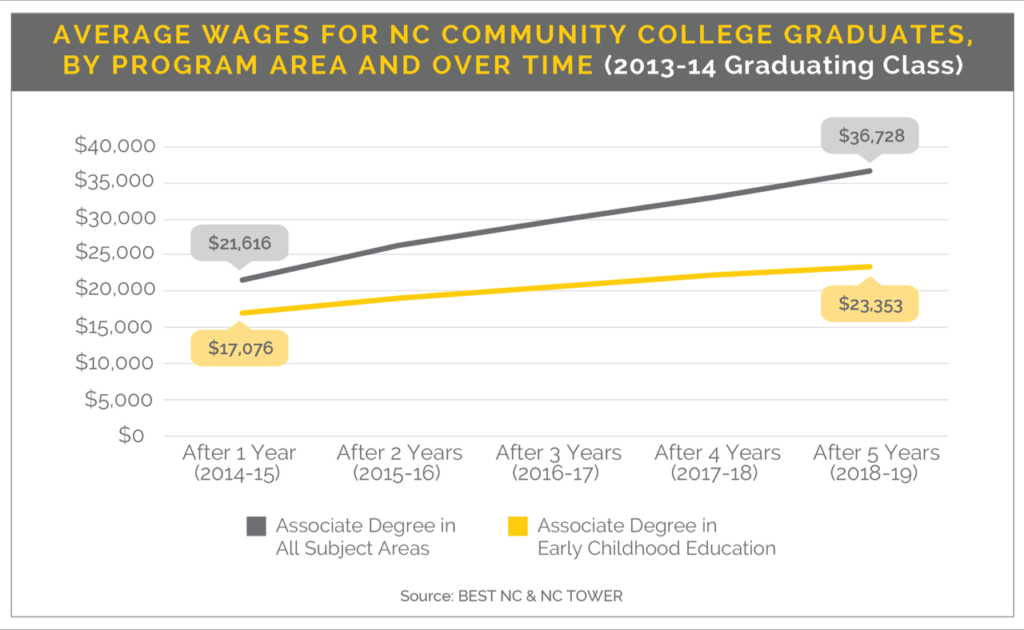
RALEIGH (September 22, 2022) – Everyone has taken a hit during the COVID pandemic. But some sectors – especially pre-school for our youngest learners – have taken a bigger hit than others.
Any way you paint it, it’s not a pretty picture. Child-care workers in North Carolina made a paltry $24,600 a year in 2020. Pre-school teachers made a median of $30,680, while a kindergarten teacher made a median of $49,540.1

The economics aren’t complicated: Without increased subsidies or reimbursements from the state, child-care centers can’t simply pay workers more and pass the cost along to their customers – working parents. Those parents are typically in the early years of their careers and often can’t afford more for child care.
Need evidence? In January 2022, the parents of 58,000 children in North Carolina received child-care subsidies reserved for families who make 200% of the federal poverty level or less. But almost 14,000 children remained on a waiting list for help.2
Child-care workers in North Carolina who work with infants and toddlers are required to take a single course in early-childhood education. Yet even those who complete an associate degree in early-childhood education at a community college can expect to see less growth in income than their peers.

Reflecting those meager wages, enrollment in early-childhood education programs at NC community colleges has dropped more than 40% since 2010.

Research has demonstrated over and over that the best return on investment of education dollars is in pre-school – it increases the probability a student will succeed at reading by third grade, math by eighth grade, and ultimately be ready for college. A Duke University study found that the benefits of quality pre-school last at least through eighth grade.3
BUNCOMBE COUNTY, in particular, has paid close attention to its pre-school workforce, in part to provide care for the children of local hospitality workers.
The county invests $3.6 million a year in early-childhood education and expects to increase from 551 children served in fiscal 2022 to 899 by the end of fiscal 2023.
Yet a recent report found Buncombe’s early-childhood workforce is “bleeding” talent. The number of child-care workers declined by 176 workers, or 17%, from 2019 to 2022.4 Similarly, the number of child-care workers statewide was down 16% from 2019 to 2020.5
The county will also use $3.2 million in American Rescue Plan dollars over the next two years to expand access to the NC Pre-K program, which specifically serves 4-year-olds from low- to moderate-income families. The funds are intended to boost funds for child-care centers and instructor pay.
“As far as those trendlines you mentioned, I’m sure if you hadn’t done all this work, they would have been worse,” County Commissioner Teri Wells told members of the Buncombe County Early Childhood Committee last month.
American Rescue Plan dollars are temporary, however.
“In an environment where it’s difficult to get workers, those barriers need to be knocked down,” Kit Cramer, President of the Asheville Chamber of Commerce, told the commissioners. “While we’re doing some exciting things with local dollars, we’re concerned about sustainability over time.”6
1 https://www.bestnc.org/wp-content/uploads/2022/07/Facts-Figures-July-2022.pdf, p. 18.
2 https://www.bestnc.org/wp-content/uploads/2022/07/Facts-Figures-July-2022.pdf, p. 6.
3 https://duke.app.box.com/s/ospjbc5z1021crd5i1cn48vzj3htu57g; https://www.newamerica.org/education-policy/edcentral/north-carolina-study-links-pre-k-middle-school-achievement/.
4 https://www.citizen-times.com/story/news/2022/09/07/childhood-workers-report-buncombe-lost-scores-early-since-2019/8005201001/.
5 https://www.bestnc.org/wp-content/uploads/2022/07/Facts-Figures-July-2022.pdf, p. 17.
6 https://www.citizen-times.com/story/news/2022/09/07/childhood-workers-report-buncombe-lost-scores-early-since-2019/8005201001/.

Leave a Reply